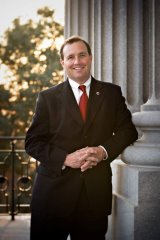This is a Letter to the Editor I sent to The State:
Recently, The State has published articles relating to the South Carolina Department of Health and Environmental Control and the Barnwell Low-level Nuclear Disposal Site operated by Energy Solutions. As Chairman of the Environmental I Sub-Committee of the House Agriculture, Natural Resources and Environmental Affairs Committee, let me clarify a few things for your readers:
This past spring, my committee began hearing testimony on legislation which would extend the life of the Barnwell site by allowing Energy Solutions to continue accepting nuclear waste from states which are not part of a regional compact. The committee heard both pro and con testimony from concerned citizens, business leaders, environmental advocacy groups and experts in the field of nuclear waste. The total time of this testimony was close to eight hours, with all sides having been given ample time to make their argument and for our Committee members to have their questions answered. During day two of the public hearings, officials from DHEC were available to answer the questions of committee members and provide whatever data was needed. DHEC officials were also available to the members of the General Assembly outside of the public hearings to provide any available information concerning Barnwell, just as they are available for assistance with any other matter we may have arise. We learned of the radioactive element tritium, pica curies and milirems.
The maps obtained by The State through a Freedom of Information request were stamped “Confidential,” meaning that at one time they were considered proprietary for the operator of the Barnwell site. In addition, one must take into consideration the world events in place at the time the maps were provided to the Agency – shortly after 9/11, when the Federal Government was issuing strong concerns to the states concerning any nuclear waste which could be used in the fabrication of “dirty bombs.” The Committee heard of the tritium plumes, the contaminated church property adjoining the site, which the operator cleaned up, and we discussed the possibilities that the Savannah River tributary known as “Mary’s Branch” may be carrying contamination toward the river. All these things, along with the history of the Barnwell site and South Carolina’s role in the disposal of the nation’s low-level nuclear waste were taken into consideration in the Committee’s decision to not extend the life of the Barnwell site by a vote of 16-0.
Throughout the Barnwell hearings, prior to the Barnwell hearings and since, DHEC has always been extremely responsive in providing the necessary information for legislators to make informed decisions. Do we always agree with the Agency – No. But for anyone to insinuate that the Agency purposely withheld information or attempted to misguide the General Assembly is ludicrous.
OK - It's My Shot: From the corner, off the Mace, by the voting board, around the gallery ....Nothing but Net
America's Debt Clock
Jeff Duncan

About Me

- Jeff
- Elected to US Congress - District 3 - in 2010 as a Republican (I am a true Conservative in the Reagan model - as my Blog will show)
Remembering
Lonesome Dove

"Uva Uvam Vivendo Varia Fit"